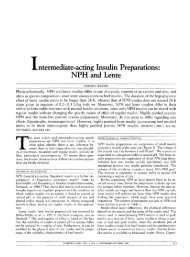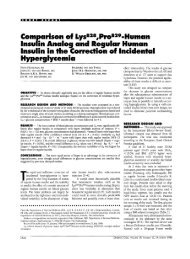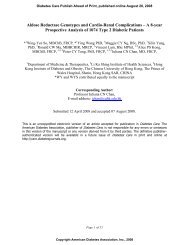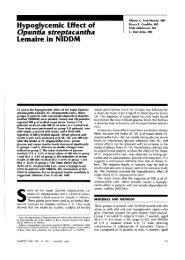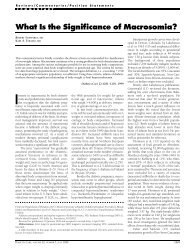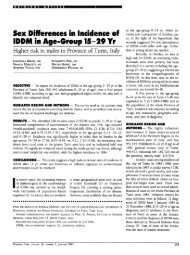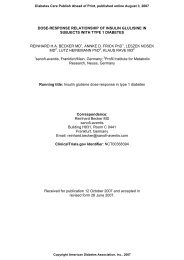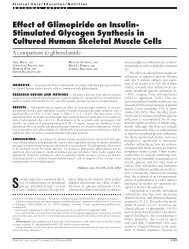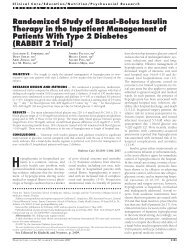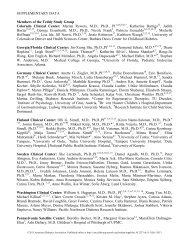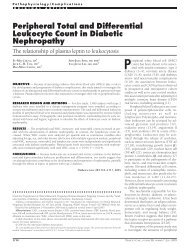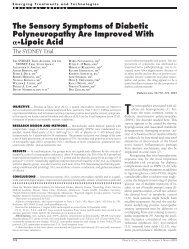Pedometers and Text Messaging to Increase ... - Diabetes Care
Pedometers and Text Messaging to Increase ... - Diabetes Care
Pedometers and Text Messaging to Increase ... - Diabetes Care
Create successful ePaper yourself
Turn your PDF publications into a flip-book with our unique Google optimized e-Paper software.
<strong>Diabetes</strong> <strong>Care</strong> Publish Ahead of Print, published online February 19, 2009<br />
RAPT: R<strong>and</strong>omised Adolescent Pedometer Trial<br />
<strong>Pedometers</strong> <strong>and</strong> <strong>Text</strong> <strong>Messaging</strong> <strong>to</strong> <strong>Increase</strong> Physical Activity:<br />
R<strong>and</strong>omized Controlled Trial of Adolescents with Type 1 <strong>Diabetes</strong><br />
Kirsty H New<strong>to</strong>n 1 MPHC, Esko J Wiltshire 2 MD, FRACP <strong>and</strong> C Raina Elley 3<br />
MBChB, FRNZCGP, PhD<br />
1 Department of Primary Health <strong>Care</strong> <strong>and</strong> General Practice, University of Otago Welling<strong>to</strong>n,<br />
Welling<strong>to</strong>n , New Zeal<strong>and</strong><br />
2 Department of Paediatrics, University of Otago Welling<strong>to</strong>n, Welling<strong>to</strong>n, New Zeal<strong>and</strong><br />
3 Department of Primary Health <strong>Care</strong> <strong>and</strong> General Practice, University of Auckl<strong>and</strong>, Auckl<strong>and</strong>,<br />
New Zeal<strong>and</strong><br />
Corresponding author:<br />
Kirsty New<strong>to</strong>n<br />
Email: Kirsty.new<strong>to</strong>n@ccdhb.org.nz<br />
Clinical trial reg. no. ACTRN012605000339651; www.actr.org.au<br />
Additional information for this article can be found in an online appendix at<br />
http://care.diabetesjournals.org.<br />
Submitted 3 November 2008 <strong>and</strong> accepted 10 February 2009.<br />
This is an uncopyedited electronic version of an article accepted for publication in <strong>Diabetes</strong> <strong>Care</strong>. The<br />
American <strong>Diabetes</strong> Association, publisher of <strong>Diabetes</strong> <strong>Care</strong>, is not responsible for any errors or omissions<br />
in this version of the manuscript or any version derived from it by third parties. The definitive publisherauthenticated<br />
version will be available in a future issue of <strong>Diabetes</strong> <strong>Care</strong> in print <strong>and</strong> online at<br />
http://care.diabetesjournals.org.<br />
Copyright American <strong>Diabetes</strong> Association, Inc., 2009
2<br />
RAPT: R<strong>and</strong>omised Adolescent Pedometer Trial<br />
Aim: To assess whether pedometers <strong>and</strong> text messaging increase physical activity in adolescents<br />
with Type 1 diabetes.<br />
Methods: R<strong>and</strong>omised controlled trial of 12 weeks. 78 participants (14.4±2.37 years, 36 (47%)<br />
male). Intervention participants wore an open pedometer <strong>and</strong> received regular motivational text<br />
messages. Control participants received usual care. Primary outcomes were daily step count (4day<br />
closed pedometer) <strong>and</strong> physical activity (PA) questionnaire.<br />
Results: Baseline median step count 11,063 steps per day (range: 1,541–20,158). At 12-weeks,<br />
mean daily step count reduced by 840 (95% CI -1947, 266) steps per day in control group <strong>and</strong> 22<br />
(-1,407, 1,364) steps per day in intervention group (p=0.4). Mean self-reported moderate or<br />
vigorous PA increased by 38.5 minutes per week in control group, 48.4 minutes per week in<br />
intervention group (p=0.9).<br />
Conclusion: A 12-week intervention using pedometers <strong>and</strong> text messaging as motivational <strong>to</strong>ols<br />
in adolescents with Type 1 diabetes did not increase physical activity.
A<br />
dolescents with Type 1<br />
diabetes require on-going care<br />
<strong>and</strong> support <strong>to</strong> manage their<br />
diabetes (1, 2). Physical activity is an<br />
important contribu<strong>to</strong>r <strong>to</strong> glycaemic control<br />
(3), has multiple effects on blood glucose,<br />
insulin sensitivity, weight management,<br />
mental health, social development (4,5), <strong>and</strong><br />
subsequent cardiovascular disease risk (6), but<br />
may not be seen as a priority by the<br />
adolescent. Physical activity often declines<br />
during adolescence as physical education at<br />
school is no longer compulsory, they may<br />
s<strong>to</strong>p playing weekend sport, achieve their<br />
driver’s license, <strong>and</strong> start after school or<br />
weekend jobs (7, 8).<br />
RESEARCH DESIGN AND METHODS<br />
A 12-week r<strong>and</strong>omized controlled trial<br />
was conducted in an outpatient setting from<br />
four regional adolescent diabetes services in<br />
New Zeal<strong>and</strong>. Participants were aged 11-18<br />
years. Informed consent, enrolment<br />
information <strong>and</strong> baseline measurements were<br />
completed prior <strong>to</strong> r<strong>and</strong>omization. Assessors<br />
were blinded at follow-up.<br />
Participants r<strong>and</strong>omized <strong>to</strong> the<br />
intervention group wore an open pedometer<br />
every day for 12 weeks, with a goal of at least<br />
10,000 steps per day. The pedometer can be<br />
opened by the participant <strong>to</strong> moni<strong>to</strong>r <strong>and</strong><br />
record the number of steps taken. Steps per<br />
day were recorded on a chart. Each week<br />
participants received a motivational text<br />
message reminding them <strong>to</strong> wear their<br />
pedometer <strong>and</strong> be active. Those r<strong>and</strong>omised<br />
<strong>to</strong> the control group received st<strong>and</strong>ard care.<br />
Primary outcome measures were<br />
change in physical activity measured by 4 day<br />
step-count from a closed pedometer, <strong>and</strong> selfreported<br />
physical activity over 7 days<br />
measured by a validated questionnaire (9, 10).<br />
The pedometer is taped shut so participants do<br />
not know the step count. Secondary outcome<br />
measures included HbA1c, blood pressure,<br />
3<br />
RAPT: R<strong>and</strong>omised Adolescent Pedometer Trial<br />
BMI z-score <strong>and</strong> quality of life (11).<br />
Adherence was moni<strong>to</strong>red in the intervention<br />
group by weekly text messages <strong>and</strong> daily step<br />
<strong>to</strong>tal charts which were collected at follow-up.<br />
It was estimated that 84 participants<br />
would be required <strong>to</strong> detect, as statistically<br />
significant, a difference between the groups of<br />
2000 steps per day or 1.5 hours per week of<br />
physical activity (alpha=0.05; p=0.8) (12).<br />
Baseline analyses were undertaken in SPSS<br />
(15.0) statistical software. Linear regression<br />
was used <strong>to</strong> assess final differences between<br />
groups using STATA (9.0). An intention <strong>to</strong><br />
treat analysis was performed assuming<br />
participants with missing follow-up data had<br />
no change over 12 weeks. Where variables<br />
were missing at baseline, these individuals<br />
were not included in final analyses for those<br />
variables.<br />
The trial was approved by the New<br />
Zeal<strong>and</strong> Central Regional Ethics Committee,<br />
CEN/05/08/058 <strong>and</strong> registered with the<br />
Australia New Zeal<strong>and</strong> Clinical Trials<br />
Register (ACTRN012605000339651).<br />
RESULTS<br />
Of the 100/154 (65%) adolescents<br />
who were eligible <strong>and</strong> invited <strong>to</strong> participate,<br />
78/100 (78%) agreed <strong>to</strong> participate (see<br />
flowchart Figure A1 in the online appendix<br />
available at http://care.diabetesjournals.org).<br />
Forty were r<strong>and</strong>omized <strong>to</strong> the control group<br />
<strong>and</strong> 38 <strong>to</strong> the intervention group. Step counts<br />
were collected on all participants at baseline.<br />
All 38 participants allocated <strong>to</strong> the<br />
intervention group received an open<br />
pedometer <strong>to</strong> wear for 12 weeks. Three<br />
participants from the intervention group <strong>and</strong><br />
one from the control group dropped out prior<br />
<strong>to</strong> follow up (5% attrition rate).<br />
At baseline, participants had a median<br />
step-count of 11,063 steps per day (range:<br />
1,541-20,158). Quality of life scores were<br />
below the normative range of 60-80% Scale<br />
Maximum (%SM), suggesting a lower quality
of life in this group of adolescents compared<br />
with others of their age (13). Boys were<br />
significantly more active than girls, with<br />
higher daily step counts (12,420 (SD 4,919)<br />
vs. 10,461 (SD 3,071); p=0.04), higher<br />
NZPAQ scores (837 (SD 522) minutes per<br />
week vs. 580 (SD 333); p=0.02) <strong>and</strong> had<br />
lower BMI z-scores (0.36 (SD 0.9) vs. 0.74<br />
(SD 0.57); p=0.03).<br />
Table 1 presents baseline<br />
characteristics <strong>and</strong> final results. At 12 weeks,<br />
there was no significant difference in change<br />
in activity measures between the groups.<br />
Daily step count as measured by closed<br />
pedometers decreased <strong>to</strong> a median (IQR) of<br />
10,159 (8,014-14,109) steps per day in the<br />
intervention group <strong>and</strong> 9,982 (8,090-12,465)<br />
steps per day in the control group (p=0.2).<br />
Differences in secondary outcomes were also<br />
not significant at 12 weeks for HbA1c, BMI<br />
z-score, quality of life <strong>and</strong> blood pressure.<br />
There was a trend <strong>to</strong>wards lower quality of<br />
life in the intervention group.<br />
All 38 participants in the intervention<br />
group were texted weekly over the 12-week<br />
intervention period unless they notified the<br />
principal researcher that they had s<strong>to</strong>pped<br />
wearing their pedometer. Seventeen (45%)<br />
lost their pedometer but these were all<br />
replaced. Fourteen (37%) s<strong>to</strong>pped wearing<br />
pedometers prior <strong>to</strong> follow-up, although 11 of<br />
these agreed <strong>to</strong> wear 4-day closed pedometers<br />
at follow-up assessment.<br />
CONCLUSIONS<br />
<strong>Pedometers</strong> <strong>and</strong> weekly text<br />
messaging as motivational <strong>to</strong>ols did not<br />
increase physical activity in adolescents with<br />
Type 1 diabetes over a 12-week period.<br />
Adherence with pedometers waned in the<br />
intervention group, with 37% s<strong>to</strong>pping the<br />
intervention before the end of the trial.<br />
Although pedometers have ‘gadget appeal’<br />
among adolescents, the appeal was shortlived.<br />
More support in addition <strong>to</strong> a weekly<br />
text may be needed <strong>to</strong> sustain interest.<br />
2<br />
RAPT: R<strong>and</strong>omised Adolescent Pedometer Trial<br />
Due <strong>to</strong> the limited number of adolescents with<br />
Type 1 diabetes in the regions of the study,<br />
<strong>and</strong> the business of the clinics, the sample size<br />
did not reach the target of 84. Even with 84<br />
participants the study would have been<br />
underpowered <strong>to</strong> detect as statistically<br />
significant the difference of 819 steps per day,<br />
instead of the 2000 steps per day estimated.<br />
While participation rates (78%) <strong>and</strong> study<br />
retention rates were high (95%), adherence<br />
with the intervention was low (37% s<strong>to</strong>pped<br />
wearing the pedometer).<br />
There were also potential biases in<br />
self-report of physical activity (reliability <strong>and</strong><br />
over-estimation both of physical activity <strong>and</strong><br />
of adherence with pedometers). In addition,<br />
participants could not be blinded <strong>to</strong> allocation<br />
of the intervention, <strong>and</strong> the motivating effect<br />
of the closed pedometer (with reminder texts)<br />
at baseline <strong>and</strong> follow-up may have inflated<br />
physical activity estimates in both groups.<br />
There is no consensus about an<br />
appropriate target number of steps for<br />
adolescents (14, 15). Even so, involving<br />
regular physical activity as part of their<br />
management remains clinically important <strong>and</strong><br />
warrants further investigation as <strong>to</strong> the best<br />
method of motivating adolescents <strong>to</strong> be more<br />
physically active.<br />
ACKNOWLEDGEMENTS<br />
This study was funded by the Welling<strong>to</strong>n<br />
Medical Research Foundation, Sport &<br />
Recreation New Zeal<strong>and</strong> <strong>and</strong> Novo Nordisk. The<br />
results of this trial were presented in part at the<br />
Australasian Paediatric Endocrine Group Annual<br />
Scientific meeting, Broome, Australia, 2007.<br />
Disclosure: None of the authors have<br />
any relevant conflicts of interest <strong>to</strong> disclose.
3<br />
RAPT: R<strong>and</strong>omised Adolescent Pedometer Trial<br />
REFERENCES<br />
1. Mil<strong>to</strong>n B, Holl<strong>and</strong> P, Whitehead WM: The social <strong>and</strong> economic consequences of<br />
childhood-onset type 1 diabetes mellitus across the lifecourse: A systematic review.<br />
Diabet Med, 23(8), 2006<br />
2. The Diamond Project Group: Incidence <strong>and</strong> trends of childhood type 1 diabetes<br />
worldwide 1990-1999. Diabet Med, 23(8), 857-866, 2006<br />
3. Bernardini AL, Vanelli M, Chiari G, Iovane B, Gelmetti C, Vitale R, Errico MK:<br />
Adherence <strong>to</strong> physical activity in young people with type 1 diabetes. Acta Biomed<br />
Ateneo Parmense, 75(3), 153-157, 2004<br />
4. Wolfsdorf J. I: Improving diabetes control in adolescents with type 1 diabetes. In<br />
Practical psychology for diabetes clinicians. 2nd ed. Anderson BJ, Rubin RR, Eds.<br />
Alex<strong>and</strong>ria, VA, American <strong>Diabetes</strong> Association, 2002, p. 149-159<br />
5. Hohepa M, Schofield G, Kolt G: Adolescent obesity <strong>and</strong> physical inactivity. N Z Med J,<br />
117(1207), 2004<br />
6. Williams G, Pickup JC: H<strong>and</strong>book of <strong>Diabetes</strong>. Oxford: Blackwell Science, 1998<br />
7. Pender N: Motivation for physical activity among children <strong>and</strong> adolescents. In Annual<br />
review of nursing research. New York, Springer Publishing, 1998 (p. 139-172)<br />
8. Richards R, Reeder AI, Darling H: Interest <strong>and</strong> participation in selected sports among<br />
New Zeal<strong>and</strong> adolescents. N Z Med J, 117(1195), 2004<br />
9. McLean G, Tobias M: The New Zeal<strong>and</strong> physical activity questionnaires: Report on the<br />
validation <strong>and</strong> use of NZPAQ-LF <strong>and</strong> NZPAQ-SF self-report physical activity survey<br />
instruments. Welling<strong>to</strong>n, SPARC, 2004<br />
10. Moy K, McFarlane K, Scragg R, Robinson S: Validation of MOH-short <strong>and</strong> SPARClong<br />
physical activity questionnaires. Final report. Auckl<strong>and</strong>, SPARC, 2003<br />
11. Cummins RA: Comprehensive quality life scale - school version. 5 th Ed. Melbourne,<br />
Deakin University, 1997<br />
12. Elley CR, Kerse N, Swinburn B, Arroll B, Robinson E: Measuring physical activity in<br />
primary health care research: Validity <strong>and</strong> reliability of two questionnaires. N Z Fam<br />
Physician, 30, 171-180, 2003<br />
13. Peti<strong>to</strong> F, Cummins RA: Quality of life in adolescence: The role of perceived control,<br />
parenting style <strong>and</strong> social support. Behav Change, 17(3), 196-207, 2000<br />
14. Tudor-Locke CE, Myers AM: Methodological considerations for researchers <strong>and</strong><br />
practitioners using pedometers <strong>to</strong> measure physical (ambula<strong>to</strong>ry) activity. Res Q Exerc<br />
Sport, 72(1), 1-12, 2001<br />
15. Tudor-Locke C, Pangrazi RP, Corbin CB, Rutherford WJ, Vincent SD, Raus<strong>to</strong>rp A,<br />
Tomson LM, Cuddihy TF: BMI-referenced st<strong>and</strong>ards for recommended pedometerdetermined<br />
steps per day in children. Prev Med, 38(6), 857-864, 2004
2<br />
RAPT: R<strong>and</strong>omised Adolescent Pedometer Trial<br />
Table 1: Baseline characteristics <strong>and</strong> mean changes in primary <strong>and</strong> secondary outcomes over 12 weeks<br />
Primary outcome measures Baseline Characteristics Mean Change between Baseline <strong>and</strong> Follow-up*<br />
Control (n=40) Intervention (n=38) Control Intervention Difference between<br />
groups<br />
P<br />
value<br />
Median (IQR # ) Median (IQR # ) (95% confidence (95% confidence (95% confidence<br />
interval)<br />
interval)<br />
interval)<br />
Daily step count 10,900 (8,324, 11,242 (8,380, -840 (-1947, 266) -22 (-1407, 1364) 819 (-916, 2,554) 0.4<br />
13,240)<br />
13,537)<br />
Moderate <strong>and</strong> vigorous physical<br />
activity (minutes/week)†<br />
Secondary outcome measures<br />
645 (298, 895) 712 (420, 1000) 38.5 (-95, 172) 48.4 (-89, 185) 9.9 (-178, 198) 0.9<br />
HbA1c (%) 8.50 (7.55, 9.3) 7.95 (7.3, 9.1) -0.02 (-0.38, 0.34) 0.35 (-0.12, 0.83) 0.38 (-0.21, 0.96) 0.2<br />
Sys<strong>to</strong>lic BP (mmHg) 114 (104, 123) 115 (106, 126) -2.1 (-9.1, 4.8) -0.0 (-8.8, 8.8) 2.1 (-8.9, 13.1) 0.7<br />
Dias<strong>to</strong>lic BP (mmHg) 67 (60, 72) 65 (60, 67) -2.0 (-6.8, 2.8) -0.7 (-6.2, 4.9) 1.3 (-5.8, 8.5) 0.7<br />
BMI z-score 0.64 (0.05,0.98) 0.62 (0.25,1.17) 0.016 (-0.08, 0.11) 0.006 (-0.07, 0.09) -0.009 (-0.13,0.12) 0.9<br />
Quality of life (SQOL)**<br />
Other measures<br />
54.9 (53.8,55.8) 55.0 (54.1,56.4) 0.21 (-0.18, 0.61) -0.71 (-1.59, 0.17) -0.93 (-1.86, 0.00) 0.06<br />
Insulin <strong>to</strong>tal daily dose (units/kg) 1.1 (1, 1.4) 1.2 (0.9, 1.6) 0.013 (-0.023–0.12) 0.015 (-0.016–0.136) 0.002 (0.006-0.01) 0.6<br />
*Intention <strong>to</strong> treat analysis assumed that in those where follow-up data were missing (n=4, 5%) there was no change in outcome variable between baseline <strong>and</strong> follow-up.<br />
#<br />
Interquartile range<br />
†Self-reported from the physical activity questionnaire (NZPAQ)<br />
** Subjective Quality of Life score 13



